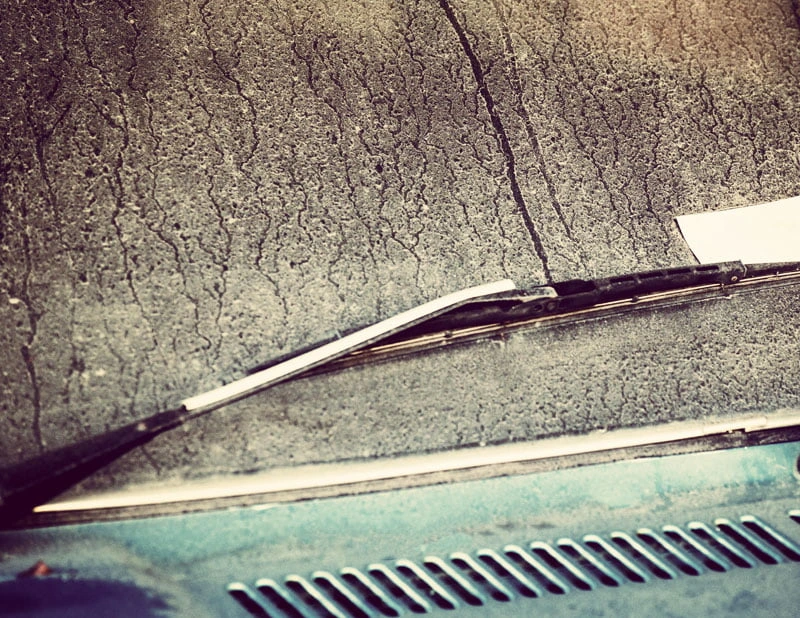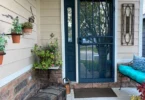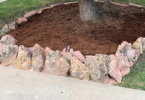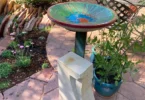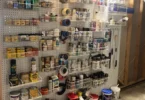I ran out of Windshield Washer Fluid again today. I thought about grabbing some the last time I was at the store, but my hands were already full. Surely I had enough sitting around in the garage (nope!)
Since this seems like pretty simple stuff, I decided to make some from things I had available. In the depth of winter, I probably will still buy the pre-mixed solution that is guaranteed for 20 to 30 degrees below zero, but for the spring and summer months, I’m happy with my DIY mixture.
Important Characteristics of Windshield Washer Fluid
To figure out what ingredients I needed besides water, I considered what characteristics are important in a windshield cleaner:
- It needs to remove, lift or dissolve sticky or dirty stuff that lands on your glass: bugs, bird poo, sticky leaf sap, muddy water that is sprayed by other vehicles running through puddles, etc.
- It needs to not leave streaks after the windshield wipers sweep it away
- It needs to not freeze inside my windshield fluid reservoir if the temperature falls below 32 degrees Fahrenheit.
- It needs to have some color to it other than clear, because the sensor in my vehicle has problems detecting the fluid. Otherwise, it will tell me the reservoir is empty even when I know it isn’t.
- It should cost the same or preferably less than the stuff at the store. Otherwise I should just plan ahead better.
How to Make DIY Windshield Washer Fluid
I started with the 1 gallon jug from the Windshield Washer Fluid that I just emptied. You can use any 1 gallon container, but those jugs are sturdy and why not reuse instead of recycle?
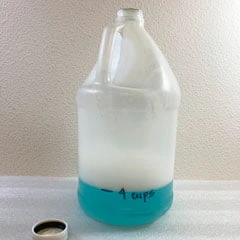
Step 1 – Add four cups of Window Washing fluid with Ammonia in it. The Ammonia is the ingredient that helps prevent streaking. Most products in this category are tinted blue, so that will help your reservoir sensor to be able to sense the fluid. 4 cups = 32 fluid ounces.
The first time you make this mixture, mark the 4 cup level of the Window Washing fluid on the gallon container with a permanent marker. That means that next time you won’t need a measuring cup.
If your vehicle’s sensor still can’t see your DIY Windshield wiper fluid, it is okay to add a drop of food coloring (preferably blue or green) into the mixture.
Step 2 – Add 1/2 cup Isopropyl Alcohol. I have 70% concentrate in my picture, but 90% or more is good. This ingredient not only acts as a solvent, but it helps prevent the solution from freezing if you happen to have a few days of cold weather.
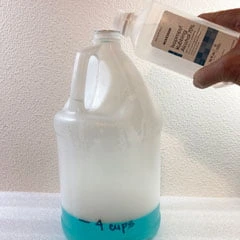
Colorado springtime always seems to have a few days of freezing weather. The Isopropyl Alcohol will also help melt any snow or ice that ends up on your windshield. If you live in a colder climate than me, consider bumping up the alcohol volume to a full cup. Even if you live somewhere that rarely freezes, the 1/2 cup of this solvent will improve the cleaning ability of the mixture, so it is good to add it if you have it available. For more about great household solvents, see How to Remove Sticky Residue from Surfaces – 9 Common Household Solvents.
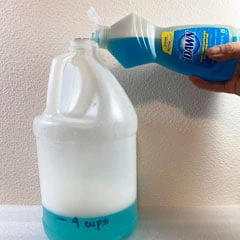
Add 1 teaspoon Dawn Dishwashing Liquid. I have the standard non-concentrated kind. If you are using the Ultra Concentrated version, just use a couple drops or the mixture will get too sudsy and won’t wipe off of your windshield very well.
Dawn is good at dissolving grease and sticky stuff, so that’s why I used it, but it’s best to use a small amount. I use Dawn for all sorts of household tasks – be sure to check out the other things it is good for at: Dawn Dishwashing Liquid.
Now slowly add water to fill the container to the top. If you get a lot of foam, let it settle for a few minutes and then finish filling the container.
Put the lid back on the container and mix to make sure the Dishwashing soap gets distributed throughout.
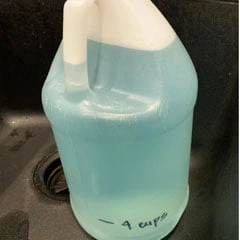
All done! Top off your windshield reservoir! Drive away into the sunset!
Cost of DIY Windshield Washer Fluid
Some of you probably looked at the 4 cups of Window washing fluid and thought “that’s more expensive than a gallon of windshield wiper fluid” and you are probably right. However, there is a much cheaper option!
I have been using the super concentrated window washing fluid, and have been mixing my own window cleaning spray for many years. Not only does this save a lot of money on this product, but it means that fewer plastic spray bottles get consumed and then tossed into the recycling bin. Window spray made from concentrate and water from your own tap typically costs about 5% to 8% of buying the pre-mixed varieties. Not only is using concentrate the Eco-conscious choice, it also makes it far less likely that you will run out of window cleaning spray. Or of Windshield Washer fluid …
Table of Contents
Featured Photo by NEOSiAM 2024+
For more automotive related articles, please see: FW1 Wash & Wax Waterless Polish.


